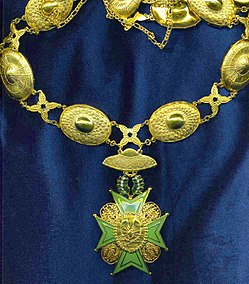| Order of the Golden Heart | |
|---|---|
 Grand Collar | |
| Awarded by | |
| Type | Order |
| Motto | "MANUM TUAM APERVIT INOPE" From Proverbs 31:20 – "She hath opened her heart to the needy and stretched forth her hands to the poor." |
| Awarded for | Distinguished services, moral aid, or volunteerism in the service of the Filipino masses |
| Status | Currently constituted |
| Sovereign | President of Philippines |
| Grades | Grand Collar Grand Cross Grand Officer Commander Officer Member |
| Precedence | |
| Next (higher) | Gawad Mabini |
| Next (lower) | Presidential Medal of Merit |
| Ribbon bar of the order | |
The Order of the Golden Heart (Orden ng Gintong Puso) is an order of the Philippines.
Contents
- History
- Criteria
- Insignia
- Ranks
- Notable recipients
- Conferred by Ramon Magsaysay
- Conferred by Carlos Garcia
- Conferred by Diosdado Macapagal
- Conferred by Ferdinand E. Marcos Sr.
- Conferred by Corazon Aquino
- Conferred by Fidel Ramos
- Conferred by Joseph Ejercito Estrada
- Conferred by Gloria Macapagal Arroyo
- Conferred by Benigno S. Aquino III
- Conferred by Rodrigo Duterte
- References

